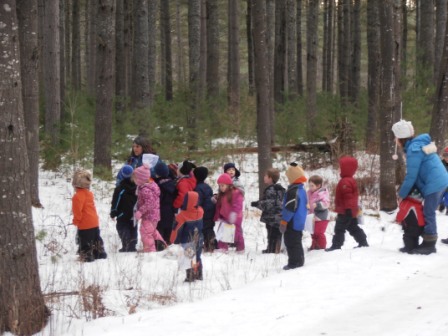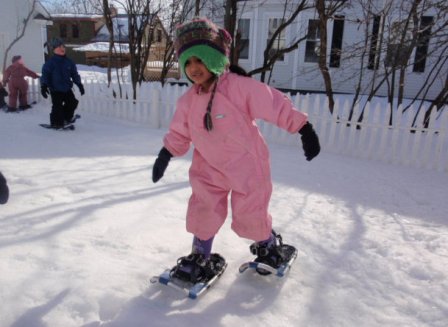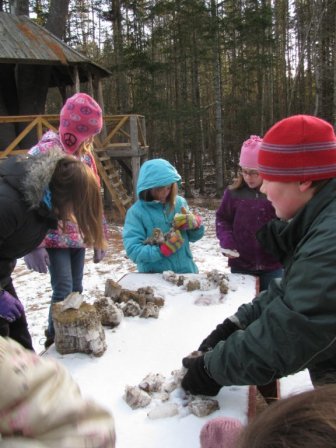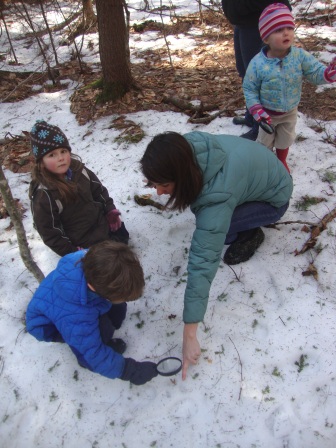 Imagine a group of preschoolers on a short walk in the forest in winter, searching for life among the trees. “Let’s pretend to be a deer walking through the forest.” As the children start to play, a cascade of questions follows as the children show curiosity and concern for how animals can live in the cold forest: “How would they walk?” “What can they eat?” “Where could they sleep?” “How do they stay warm?” Feeling the cold and laboring through the snow can make abstract concepts like winter adaptation come alive for even the youngest learners. Other outdoor activities can be equally engaging for older students.
Imagine a group of preschoolers on a short walk in the forest in winter, searching for life among the trees. “Let’s pretend to be a deer walking through the forest.” As the children start to play, a cascade of questions follows as the children show curiosity and concern for how animals can live in the cold forest: “How would they walk?” “What can they eat?” “Where could they sleep?” “How do they stay warm?” Feeling the cold and laboring through the snow can make abstract concepts like winter adaptation come alive for even the youngest learners. Other outdoor activities can be equally engaging for older students.
Getting children outside, especially during winter months, can feel overwhelming, but we encourage you to make the effort. Teaching outside throughout the year can lead to a classroom full of curious, motivated learners who have a deeper connection to the place where they live.
Prepare for the Special Challenges of Winter
 In Maine, where we live, winter air temperatures often hover around zero degrees, so simply being outside can be a safety concern. You’ll want to ensure that your students are prepared with warm outdoor clothing, that you have chosen an appropriate place for your outdoor lessons, and that students and teachers are comfortable learning in this new setting.
In Maine, where we live, winter air temperatures often hover around zero degrees, so simply being outside can be a safety concern. You’ll want to ensure that your students are prepared with warm outdoor clothing, that you have chosen an appropriate place for your outdoor lessons, and that students and teachers are comfortable learning in this new setting.
Consider factors like snow depth, air temperature, wind chill, and ice safety before every outdoor winter lesson. You may have to reschedule if it is too cold or snowy. Think about how difficult it might be for an emergency vehicle to reach your students if something happened. Always take a radio or cell phone with you so you can call for help in case of an emergency.
If possible, have some donated extra boots and clothing on hand for the few children who do not come prepared. Some older students may not be willing to wear clothing offered by the teacher. When faced with this situation, we arrange for an indoor place where these students can remain while the rest of the class goes outside. Ask a fellow teacher if these students can sit in the back of their classroom. Assign these students indoor bookwork, and include a homework component if they want to receive credit for the lab day. This offers a safe, but challenging, indoor option for unprepared students.
 Make Outdoor Work Part of Your Regular Routine
Make Outdoor Work Part of Your Regular Routine
Start getting your students outdoors at the beginning of the school year. With routines in place, students know what to expect and how to behave, and can focus on the lesson rather than on the fact that they will be going outside. By starting early, you will overcome the typical challenges of outdoor teaching before the snow falls, giving you more mental space to deal with the additional difficulties winter poses.
Secure Support from the Community, Parents, and School
Notify parents well in advance about your outdoor teaching plans. Building support within your school community can go a long way toward enabling outdoor education. You may find a group of colleagues eager to set up a simple outdoor classroom or willing to collaborate on lessons. If you cannot find a support group within your school, parent volunteers or a local environmental organization may be able to assist you. Your PLT State Coordinator can help by conducting a workshop for your school or in your community.
Incorporate Winter Learning Into a Year-long Investigation
Consider incorporating your winter teaching into a year-long project that will provide the continuity needed to get kids comfortable with outdoor learning. A great example is Activity 21, Adopt A Tree found in PLT’s PreK-8 Environmental Education Activity Guide. Observing the same tree—or the same special outdoor spot—over the course of the school year offers opportunities for your students to become more engaged as they make regular scientific observations over time. David Sobel’s book, Childhood and Nature: Design Principles for Educators gives some great examples of how to give each child a special place and turn it into a year-long project.
Lessons to Inspire by Grade Level
 Early Childhood
Early Childhood
PLT’s Early Childhood Activity 6, Evergreens in Winter offers a variety of experiences for children to touch, smell, see, hear, and taste the season of winter. Start with something small, for example, using our Connecting Kids to Nature series. Sometimes the best thing for young children is to simply play and explore; unstructured play often offers the best learning. Preschoolers love paths or mazes in the snow. Simply shoveling an interesting path can lead to hours of fun and exploration. If your kids tire of building a snowman, try sculpting an awesome animal with them! Here are some ideas for animal snow sculptures from the National Wildlife Federation.
- Elementary
PLT has many activities that ask children to collect and observe. Be mindful in winter that students will be wearing gloves so limit writing requirements when outside. Consider encouraging students to snap photos of animal tracks or collect twigs for closer examination once back indoors. Remember trees can be identified by many different features, not just by their leaves. Consider asking children to identify trees by their bark using PLT’s PreK-8 Activity 68, Name That Tree. - Secondary
Incorporate teaching outdoors in the winter into a bigger project that has more meaning and motivation than standalone lessons. For example, PLT’s secondary module Focus on Forests Activity 1, Monitoring Forest Health offers students the opportunity to work on forest research plots on the school property throughout the year. Dichotomous keying activities, required in most biology curricula, can be completed using tree identification in all seasons.
The most important thing to remember is proper preparation. Once you’ve done that hard work, you’ll be pleased to see that teaching outside is not only easy, it’s also fun and rewarding for both teachers and students!
Photo Credits:
- Photo 1 – “Class in Winter” taken by Joanne Alex from Stillwater Montessori School in Old Town, ME.
- Photo 2 – “Girl on Snowshoes” taken by Joanne Alex from Stillwater Montessori School in Old Town, ME.
- Photo 3 – “Ice Crystals” taken by Anita Smith, Maine PLT Steering Committee member.
- Photo 4 – “Place Based Winter Preschool” taken by Corie Scribner.
Corie Scribner and Olivia Griset worked together on this article. An elementary school teacher for 15 years, Corie has always been drawn to sharing the natural world with children and her family. She also teaches a nature and play-based kindergarten and leads nature-based classes for local families.


